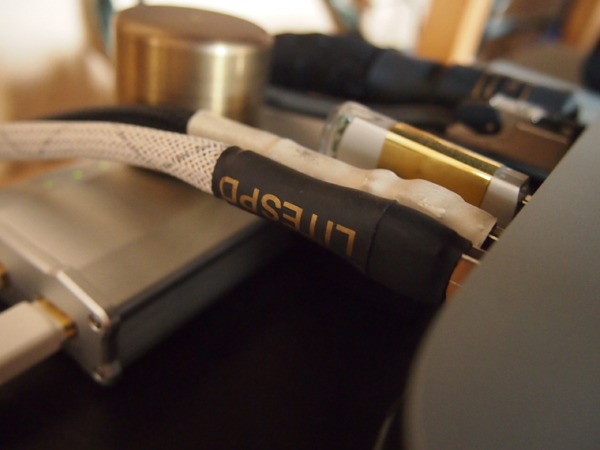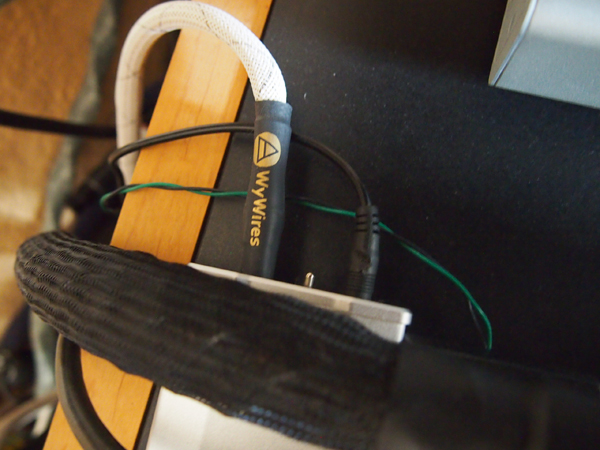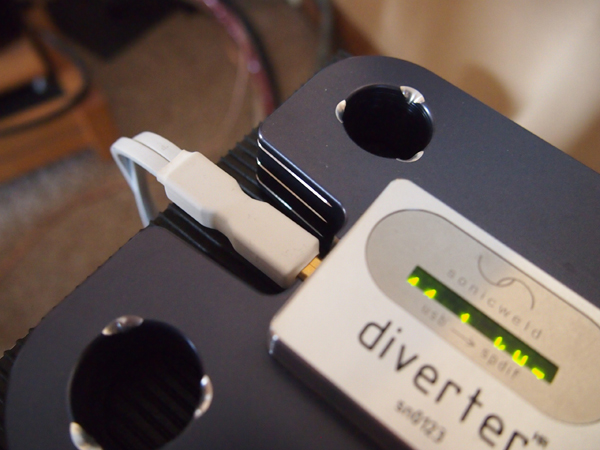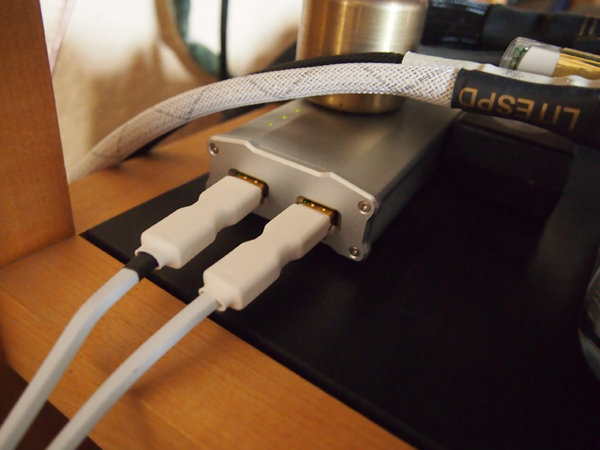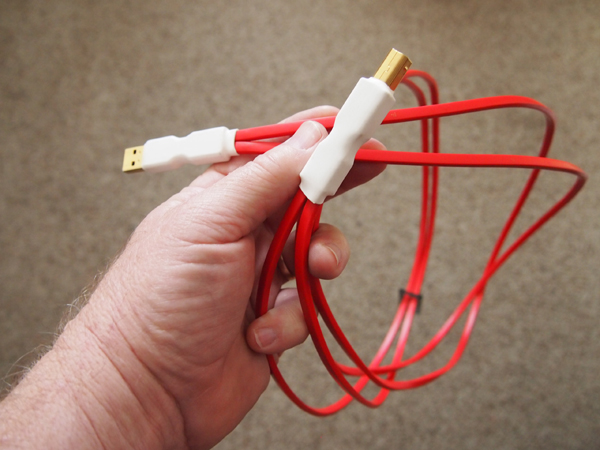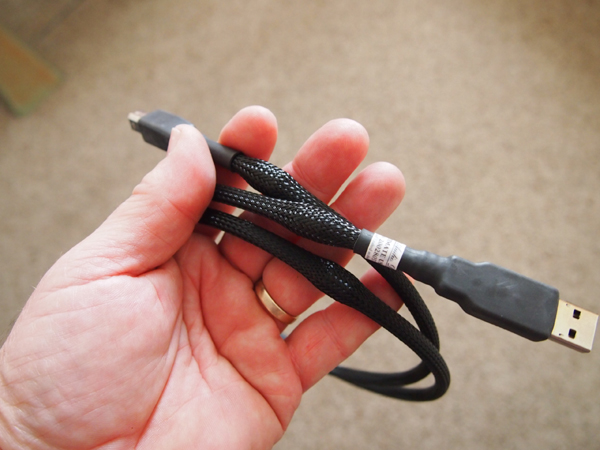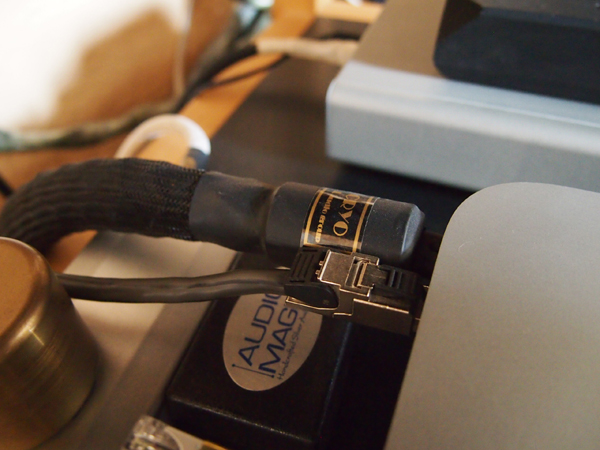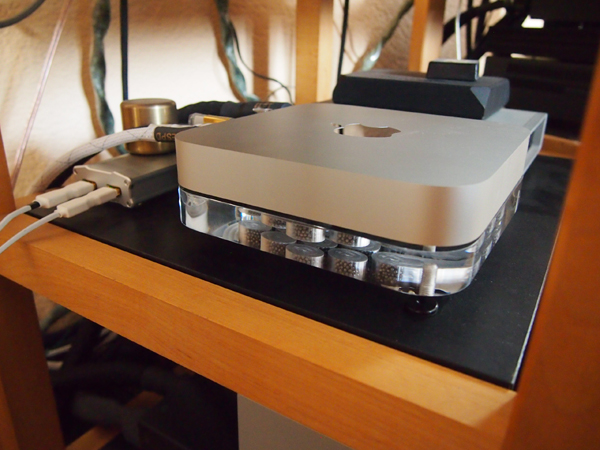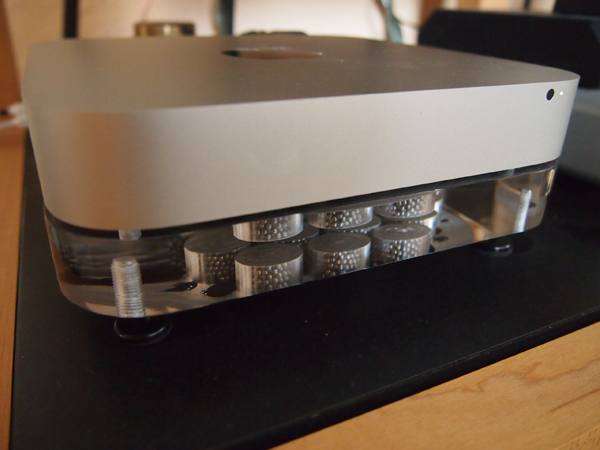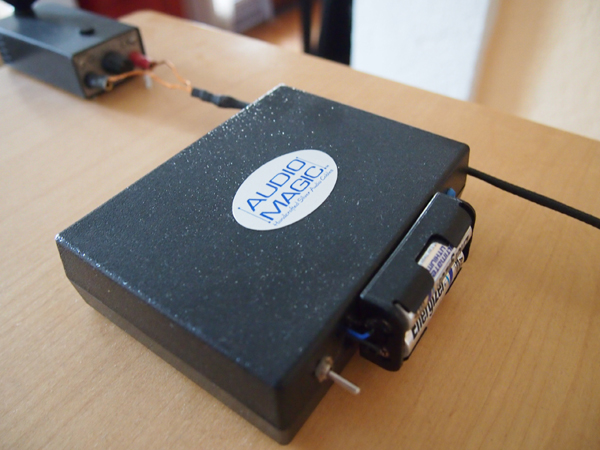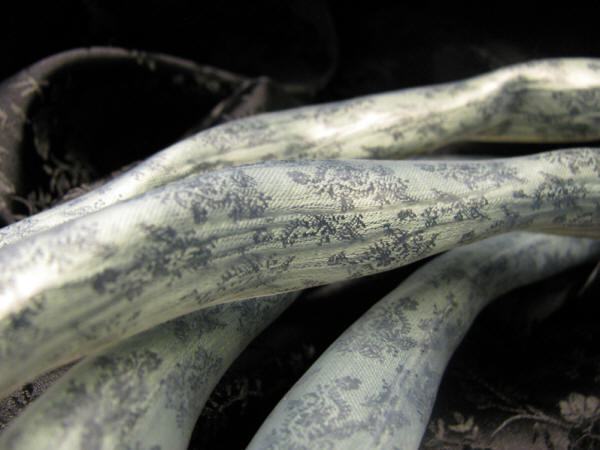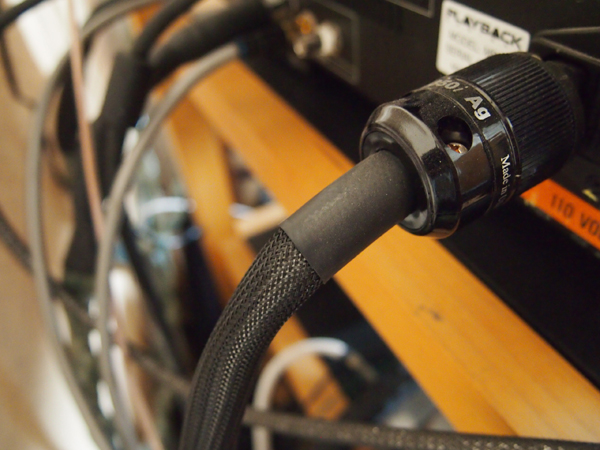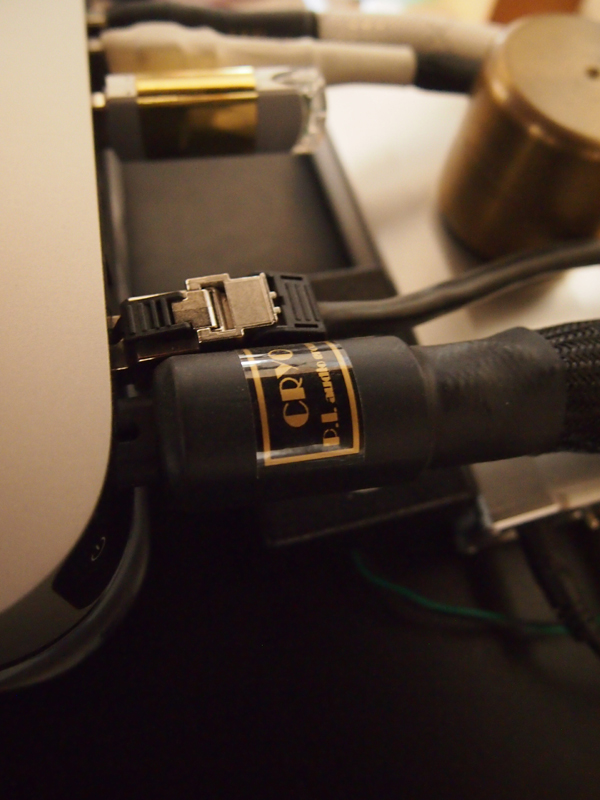You are reading the older HTML site
Positive Feedback ISSUE 70
Audio Ramblings -
2013 End of the Year Round-Up... Products From: WyWires, Purist Audio, Light
Harmonic, Audio Magic, Audioquest, Atomic Audio Labs, Pi Audio, and Skogrand! All images by me, except those of the Skogrand Cables.
Chris Sommovigo posted this in a thread about Synergistic's RMAF demo … "Measurements allow us to create a representative abstraction with which to try and understand aspects of performance, some of them very fine aspects—but just because the measurements can represent all that we know about these phenomena doesn't mean that they, perforce, represent all that is there, all that we will ever know about it. The limitation of measurement is simple: measurements cannot account for what they cannot account for. And to pretend, as it seems you do, that perceptible phenomena are limited by the limits of measurement (and the paradigmatic contexts that lend them and limit their meaning and usefulness) is to work an equation from the result, backwards. If you're missing a variable in the equation, your assumptions about the operators may be correct ... but incomplete. The "objective crowd" (who nevertheless are far from objective, believing superstitiously—as they do—in the incontrovertibility of abstractions such as measurements) reject the empirical reports, across multitudes of listeners over several decades, of perceptible phenomena and, therefore, consider the evidence unfit for consideration. It's as if they are saying, "I'll believe that there are cherries just as soon as you prove their existence using our oranges." This tendency to reject data that do not fit their carefully constructed prejudices based, as it is, entirely on the superstitious belief that their particular set of abstractions represents the whole truth instead of just a temporarily useful model, is symptomatic of stymied and lazy thinking." And to paraphrase Tim de Paravicni from a conversation he and had one evening after dinner here in Long Beach… "Too many people do not know what to measure… and often times, what they measure has little to do with what we hear…" I also took a beating by one of our readers over my comments in reference to power cords and AC conditioners (Issue 53) where I wrote… "Too many people hear a difference to make it a scam, and too many who do, know enough not to be scammed. The problem is not that people have differing of opinions, but how people who have different opinions or beliefs react to those that differ from theirs. See I toss and turn at night wondering why it is that those who claim differences cannot exist, will not exist, should not exit, and do not exist… all of which is based on 1) that they do not hear it so no one else can, and 2) there is no reason or scientific explanation why they should be able to anyhow… worry so much about those of us who do hear a difference and yet don't give a rat's ass why we do? In simpler terms, my real beef is why is it that those who do not hear the 'things' like we do get so worked up about it? Is this all you have going for you in life? Is this your calling? Why is it such an issue? Give it a rest … your panties have to be getting mighty uncomfortable being all bunched up like that. Besides, the idea that you spend so much time arguing and attacking those who hear whatever that disagrees with your beliefs and experiences suggests that deep down you actually hear it too… you're just a closet audio-guy and won't admit it. People tend to fight what they fear to be true because they can't handle the possibility that they are members of that tribe…" His comments dealt with me… being too aggressive, not allowing for differing opinions that reflect science and fact, claiming that a subjective opinion, or one's perception, should never be challenged (he posted that Science should have the final word in terms of double-blind testing), and to quote, "that there's too much evidence that people tend to hear what they expect to hear, or that bias is inevitably present in sighted listening, to draw conclusions without any objective method. I mean, people even hear differences when no switching is made, that current designs are immune to the last few feet of wire (Specifically, presumptions about power cords have been crushed by theory. Power supplies in audio devices of decent quality are capable enough to make it a non-issue, and it's simply not possible that the last meter of AC power line could make such a difference considering the distance between you and your power station that have not been treated)." Why, then, argue and why not let people who can hear a difference live in peace. The point is that your blog is public. I don't mind if you or anyone else claim to hear differences, and feel happy about it. You're misleading other people. That is the problem and the reason why you get opposition. Audio is not a religion, and no one should be considered to have the truth. Human are also an unreliable source of information. Perceptions are malleable. Science has brought us away from superstitions, mystical gurus, and self-proclaimed authorities." Without a doubt, I was rather aggressive. But that comes from the continued banter from those who do not hear a difference because they know there can be no difference and so there is no difference unless you are the town fool… and so for me, enough was enough. For whatever reason I do hear a difference and for whatever reason you do not hear a difference. And for sure, people are biased… but that bias will run both ways: one can be biased to hear difference because we made a change, the item is more expensive, or possesses some engineering breakthrough or special sauce… but one can also be biased to not hear a difference simply because you know there can be no difference because… well, fill in the blank. Sure I would love to believe that if something costs more you get more, but then I do find the opposite to happen and more is not always more. And yes, there is a lot of stuff floating around in the audio-sphere that defies any sense of logic or acceptable scientific explanation… or is measurable or quantifiable under a controlled test. But some, no make that a lot, of this stuff does something… something better/different that is heard in too many instances where two people are not aware of what is going on, but without a doubt, sometimes this stuff doesn't make a difference at all. We do not listen to music under controlled conditions, nor do we live in a bias-free world. Yes, I hear what I hear and yes, many times I am at a loss to explain as to why I hear it… that is, what is actually going on with the device in use in terms of design and whatnot to make any sensible difference. And am I fooling myself? I doubt that, as too often I ask others who drop by to listen, those who are not privy (therefore being blind) to what I am doing and they too hear differences (better and worse)… and do so after not knowing anything was changed. And sorry, but having to arrange for double-blind tests is simply not practical. So what I report hearing is simply what I heard… supported by others. It is not the word or truth that anyone is required to follow but an honest and open account of my experiences. I am not preaching to anyone… just sharing what I experienced. In the end, you have to listen for yourself. So where does this all lead me? To what I have heard (experienced) recently with USB cables by WyWires, PAD, and Light Harmonics, to the Cat700 Ethernet cables from AudioQuest, to a platform for a Mac Mini from Atomic Audio, to a very unique device from Audio Magic, to interconnects and speakers cables from Skogrand, to a 'digital' power cord from PAD, and to a 'digital source' AC power cord from Pi Audio. I will try to not make this too long and drawn out… so here we go, but keep in mind differences are just that: differences, and in many cases are difficult to put into words. Sure we can hear more of this and less of that, but more often I find that what I hear to be a difference, while WAY better, is not easily described in the typical audiophile-speak. It is not so much that there is more or less of something, it is more about the engagement and overall musicality of what is being played… more about the organic-ness or rightness of the presentation. Very much an intangible quality that does not equate to sonics or simple terms with regards to frequency descriptors. Anyhow the following products had that quality in spades!
WyWires Litespd USB Cable I simply love the Litespd (Gold with Bybee Slipstream Purifier - $799 for 1.5 meters) USB cable from WyWires—a cable company building what they do by what is known, and by what they hear. It does so much right musically without drawing attention to itself. That is, the WyWires has so little character to add to the music… or to detract from the music. But in no respect does it present the music as being characterless! It presents the music as an organic whole with wonderful resolution, warmth, detail, texture, extension, dimensionality, flow, energy, and so on. Really impossible to fault as it equals my long-time reference Locus Design at a fraction of the price (miss you Lee!). Flexible and trouble-free, the WyWires has no issues with any file (DSD and whatnot) and serves my music quite right. Sit back and enjoy your music (err... files) at a level previously unheard of… nice! A clear winner and a cable I find rather difficult to not have in the system when listening to my music. Works especially well combined with the iFi USB Power unit (review to come soon) and the LightSpeed USB Cable from Light Harmonic. Together, these three pieces elevate my musical experience to levels I have never experienced prior.
Light Harmonic LightSpeed USB Cable I also love the Light Harmonic (LT) LightSpeed USB Cable ($1399 for 1.6 meters). This cable comes from a company that is known for their Da Vinci DAC along with the Geek Out, but is not known as a cable company. What we have here is their answer to the issues they saw in all USB cable designs: insufficient bandwidth, lack of bit-perfect-ness, and noise. (Before Light Harmonic, Larry Ho worked as the Executive Vice President of a leading USB integrated circuit company. He and his team of over 150 electronic engineers contributed vital work to the USB 2.0 Audio Class Standard, and developed USB DSP software drivers for partners like Dolby, DTS, and Sennheiser… so he knows his stuff!).
The LT is unique in that they have separated the power and signal legs of the cable to address noise and other issues… and you can hear that in how the music comes from a blacker black… or quieter quiet. The separate legs are also available in a version featuring individual power/signal USB-A connectors if you have the requisite component in that has individual power/signal USB-B connectors (self powered items).
Very, very similar sonically to the WyWires where differences become more a splitting of hairs, though with the LT you simply get more of everything. Not a 'night and day' more, but yeah, it is there. Is this because of less noise, greater bandwidth, and so on? No idea, as I have no idea if the WyWires is noisy or not. LT will tell you, though, that their cable does require break-in and after several hundred hours it is measurable in terms of distortion—that is, there is less, meaning you hear more (oh, science!). I do find the LT to be a wee bit lighter than the WyWires… just a touch less heft and weight. A coloration in the WyWires? No idea, but I do like that coloration over one that is the opposite—mean and lean. Of which the HT is clearly not. The LT is extended, resolute, and damn nice with my music. No hint of grain, edginess, glare, grit… nothing even close to being a distraction or characteristic of digital gone bad. This is a stellar product in every respect and clearly has to be on anyone's list of must haves.
PAD Ultimate USB Cable And damn it, I also really like the PAD Ultimate USB cable too ($995 a meter)! Life is just too good sometimes. This Ultimate cable also gets the bits across in fine fashion. Yeah, it too rivals in oh so many ways the two above—extended, clean, harmonically rich, musical… you get it all. Now Jim Aud has the 'holistic approach to designing cables that is based on scientific principles' crowd where having a background in physics allows him to make things really, really quiet. Not sure what he is doing (the Ultimate USB does have small bulges at either end, so perhaps he is using ferrites or something) but this cable sings… and does so rather quietly too. That is, the music is there, but not the crap that gets in the way. Again, this cable fits right with the two above, though it might be a wee bit more forward through the midrange. Now that is a wee bit… but it is not as big sounding as the other two… oddly I would characterize the PAD cable as being more structured or organized; neat and tidy with everything in its place… a sense of calm wholeness to the music. Hard to describe big sounding… but compared to the PAD, the WyWires and LT come across as louder—more like sitting closer to the band as opposed to sitting a few rows further away. Now this is not a distraction as I love spending time with this cable… it is just a different presentation of sorts: chaotic energy and excitement (tactile involvement?) as opposed to the PAD's calmer wholeness of structure. Another winner for anyone wanting to hear what is really happening. I need to diverge here a bit to mention someone who wrote that for any USB cable to make a difference, the USB interface/circuit in the device would have to be poorly designed. That is, if we hear a difference with USB cables, then the USB circuit design is either bad or I suppose, we are biased and/or fooling ourselves. Gee, if that is true then there appears to be a whole lot of bad designs out there… many from people with a strong pedigree in just that field (Centrance, Light Harmonic, etc.) and a whole lot biased in favor of cables. This person continued that they do not hear any difference in USB cables with their own 'custom' digital designs—of which I say fine, good for you—but then the assumption, based on their own comments, is that they are the only person with the knowledge to design a proper USB interface/circuit that is immune to the claimed affect of any USB cable. Now that would be rather ludicrous and… well, gee… really, really presumptuous. Meaning that they alone are sole holder of how to properly design a USB interface? I am going to be nice here and just say that perhaps this person is simply biased against cables and so does not hear what so many do hear... or is delusional with grandeur. Alright, so I wasn't all that nice. Oh, and all my USB comments come from comparing any mentioned anywhere to that heard from various generic USB cables, as well as my experiences with the following USB cables: Cardas, Furutech, Oyaide, Audioquest, Locus Design, Nordost, and Elijah Audio.
CAT700 Carbon Ethernet Cables from AudioQuest Hey look… if USB cables can make a difference in what you hear (and it ain't just me man… anyone who has been here also hears a difference between the cables, and more often than not, in a blind condition), then why not Ethernet cables. Specifically CAT700 Ethernet cables from AudioQuest. Last June Carol and I, along with 20 or so other kidnapped audiophiles, were presented with a demonstration of the AQ Ethernet line of cables at their place of business down in Irvine. Simple enough, the demo was moving from wireless to generic and then up through their line of Ethernet cables. Differences were not subtle, and defied what many of us expected to hear. It was pretty much, "Wow, how could an Ethernet cable make such a difference?" and gee… they were only using 4 foot lengths to demo the improvements. I had to try them here, between my Drobo and Mac, and so after a few emails between Steve Silberman and myself, a box arrived with a 40 foot and 15 run of their Carbon Ethernet cable ($13 a foot, standard 6a/7 connector $2.50 each, or the Telegartner connector which are $20 each). These cables I have came beautifully terminated with the Telegartner connectors, and since mine were to run under the house, do not feature a fancy-schmancy jacket, but hey, if we are going to use the best cables elsewhere, why short change the system with cheapo generic Ethernet cables from the local computer outlet? Now, audible conclusions are a bit more difficult to come to here as I have shut everything down, drill a few holes here and there to feed the cables through, and then go under the house to run the cables… all the while dodging spider webs and rat droppings. I hit my head a few times on the floor joists, almost got stuck crawling between the foundation supports, and came out covered in fine silt… this is not a fun thing to do, and not something that happens quickly at my age. Oh the joys of reviewing! But after all is said and done I did find more of the music happening in the room. Bigger, faster, healthier… gee, nice. Just what we had experienced at the demo—the music came across with more life and presence. Heft, space, palpable, ease, less crap… nice. Is any of this measurable? Is any of this probable? I mean less crap would equate to less distortion or noise… more bits… cleaner bits. That would be measurable, no? I have no idea, as I have no way to measure other than what I heard. It simply sounds better with the AQ Ethernet cables in then with them out (I have done a few A/B comparisons, but what a PITA having to shut everything down to reconnect—computer, Drobo, etc.—and starting everything back up to listen again…). All I can say is that I experience more of what I want to hear as if more of what was or is getting in the way is now gone. Makes sense as the Carbons are built to do just that based on AQ's highest possible standards and materials—keep the crap out and transfer the bits without any degradation. I like these a lot.
Atomic Audio Labs MacMini Platform Atomic Audio Labs makes some really sweet platforms that are designed not so much decouple, but are also tuned to the exact resonance frequency of the Mac Mini so that it cancels out internal resonances. Cool. Of course, the effect would be (should be) more pronounced in Macs that use a conventional HD as opposed to those with an SSD—moving vs. not moving. Mine is SSD… but still… Priced at $349, this work of visual industrial art does some interesting things. Place it under a Mac Mini and you should hear more of what is in your music with less of what you do not want to hear in your music… like anything that detracts from your enjoyment. What I mean is that just about anything and everything will vibrate, and hence resonate at some frequency, especially your audio components as you turn up the music (heck even if you aren't playing music it will do this since moving parts create vibrations). Either it is okay or it is not. Either you don't hear it so you don't mind it, or you do hear it and so you do mind. It gets in the way obstructing or muddying up the music with vibrational muck, or you are living in bliss and it all sounds fine. What I experienced with the Mac Platform is a sonic shift that is an audible increase in resolution, along with more coherency. All music came across as sweeter, more extended, less effort, with longer decays and air… all very nice. And it looks really cool too. The Platform is shaped to fit any Mac Mini released after 2010, is precision CNC machined from a 1" thick slab of clear Acrylic, and the "pockets" hold a precisely calibrated amounts of lead to 'address' the resonances and weight of a Mac Mini.
When it comes to any coupling/decoupling/tuning/isolation support or footer will do something. The task is to find one that does what you want it to do… and do enough so that it matters. Much like a wine or adult beverage… find what you like.
The Pulse Electron Alignment from Audio Magic The Pulse Electron Alignment from Audio Magic ($600 each) lies within the realm of hard to explain or better yet, hard to believe. From the Audio Magic site…"The P.E.A. is designed to produce a pure spin current inside the gear that it is treating. Electrons either have a spin-up or spin-down cycle which can affect the operating guideline of different components' internal workings. By aligning these electronics in a cohesive path, the components internal parts work more efficiently." Now I have no idea what this all means, or if it even means something, let alone if it is even possible to accomplish in such a device. No doubt there are readers out there with enough knowledge to say either it is BS or it is real… and then possibly possible. I have done some web searching, and what I find far exceeds my feeble ability to understand Physics (I bailed early and only took Physics 1 in college—not my cup of tea) and so maybe… could be… might be… but gee, got me! What I can say is that the device is powered by 2 lithium AA batteries, and is to be placed either inside a component or on top—whichever is most practical. I placed them atop my Teton loudspeakers pretty much centered towards the rear so that they were as close as possible to the crossovers. Switched them on and well… damn! No explanation can explain how the music is pushed further out into the room. Not a shift tonally… that is an emphasis in the mids, so the music sounds more forward. No, the music is tonally and harmonically the same, but for lack of a better descriptor, it is shot out into the room. More speed… more space. More space as the music is out in the room and less around the speakers. The jump factor jumps, the dimensional factor is more dimensional, and the propulsive factor is set to 11… weird to say the least. You feel more of the music; you experience more of the music as it is closer to you. The Pulse Electron Alignment clearly does something, and something I really like. Other people have heard this shift forward too… and so wow. Way cool. Even casual blind tests have revealed a difference… where listeners have said that it is a difference (on versus off) in moving the sound out into the room, away from the speakers. Jerry is really onto to something here. In talking to him, he will say that he is working closely with people who know, are in the know, about this area of Science to bring such a device to the market. Whether is does what it does because of the explanation given, I cannot say… all I can say is that they do something really good! I love them and have purchased the pair. Oh, quick update... Jerry has a new 120V unit. Nice!
Skogrand SC Markarian 421 speaker cables (1m: USD 6950, 1.5m: USD 7550, 2m: USD 8150, 2.5m: USD 8750, 3m: USD 9350, 3.5m: USD 9950) and SCI Markarian 421 interconnects (1m: SD 6350, 1.5m: USD 6950, 2m: USD 7550, 2.5m: USD 8150, 3m: USD 8750, 3.5m: USD 9350). A few other PF writers (Here, Here, and Here) have already spilled a fair amount of ink on these amazingly, musically rewarding cables, but I am going to offer a more thorough review next year. What I can say here is that these are a true statement in overall musicality. They are as equally balanced as anything I could ever ask for while being rich tonally, and harmonically right. Extended as all get out, grain free, airy, yadda, yadda… the Skogrand are a true statement product; these are reference cables for any music lover to seek out. Not inexpensive in the least… all Skogrand cables are painstakingly handmade over many days, and feature (taken from their site): solid core copper leads suspended in air within a framework of ultra low dielectric fabrics and PFA tubing, an effective dielectric constant of 1.0018 with a signal transfer speed of 299253.8km/h or 99.82 % of the speed of light, pure silk brocade cable sleeves, and 2 x 12 AWG UP-OCC 7N solid core copper leads. The cables offer a robust sound that is warm and rich and yet… never overly so in any way that is not right. Resolution, along with all that any music lover would want from their music, is presented in a relaxed, and yet, visceral presentation. I know that this all sounds like you are getting the yin with the yang… but that pretty much sums it up. I can find no tradeoffs or shortcomings. Truth is, when the music starts I stop thinking about the bits and just listen. I will add that these cables are stiff, and so they really do not easily bend into place. Care has to be taken then to not force them to fit in tight quarters… though it is easy enough to ask them to be shaped to fit your needs. I cannot recommend these cables highly enough! They are simply the best I have ever heard at making the magic happen. Way more to come!
PAD Aquila Digital ($905) …" It is made for the digital format with precise attention to shielding and careful use of ferrite materials. The Aquila Digital AC's construction prevents the transmission of Electromagnetic Interference (EMI) signals from other digital devices to the power supply." I have this feeding the AC to the Playback Designs MPS-5, and it does quite well there. In many ways it resembles what I hear from the Dynamic Design Spirit-C Digital cord https://positive-feedback.com/Issue53/bybee.htm but with a boost in overall musicality. Not a dramatic difference, as the Spirit-C is so very right on the Playback, but the Aquila presents the music with just that much less stress, and just that much more ease… both of which allow for anything the PD is dealing with music-wise, to sound that much better! With the Aquila, there is a wonderful sense of organic naturalness to whatever is coming out of the PB; quiet and refined are apt descriptors. Robust, articulate, and oh so resolved, work too. The Aquila's presentation is so tonally even, with extension and slam, one is bound to second guess the cable's performance based on initial perceptions alone. That is, how can such an affordable cable (well, yes that is open to discussion, but within the PAD line the Aquila is rather inexpensive) with a diameter of your index finger can do all that it does. Yes, this is not a garden hose gone wild cable… sorry, but the Aquila's dimensions are more reflective of a normal sized stock cord. So a visual bias is not going to happen. Good job Jim! Very, very nice in every way. Love this cable!
Pi Audio MPC/Mini++ AC Cord Based on 14 ga cryogenically treated copper with Furutech plugs, Pi Audio MPC/Mini++ (14 ga cryogenically treated copper - 1.5 meter $499) does wonders on any Mac Mini. You get a boost in all the stuff you want without a boost in all the stuff you don't want. What I mean is that compared to a stock cord, music takes on more drive and a dimensional palpable presence. Resolution is improved seven-fold; the music flows out into the room with a natural ease and liquidity, and you hear it all in a way that is never fatiguing or non-engaging. The music has that quality of there being less crap in the way… that is, one can simply hear more of the music. Same with the Aquila… something cool is going on here! I will say though, that if you want to use one, and the AQ Carbon Ethernet cables, then Dave Elledge has to be told ahead of time, as the two cable ends tend to fight over what limited real-estate exits on the rear of the Mac. Apple has the IEC and Ethernet connections very close together… so close that I was only able to use one or the other… but not both till Dave modified the IEC by trimming it down a bit. Even so, it is still a tight fit. In the end, I have found the MPC/Mini++ to be a wonderful addition to the computer-based audio rig… so much so I bought the review sample. Give one a try, and you too will be smitten. I know I am and have purchased the review sample! So what I have here is a round-up, of sorts, of products that have really made my music listening just that much more engaging… just that much more fun. All are highly recommended!
|



